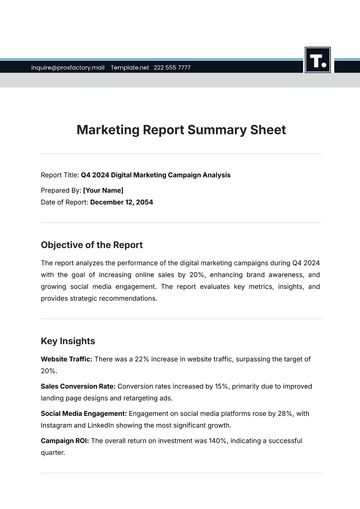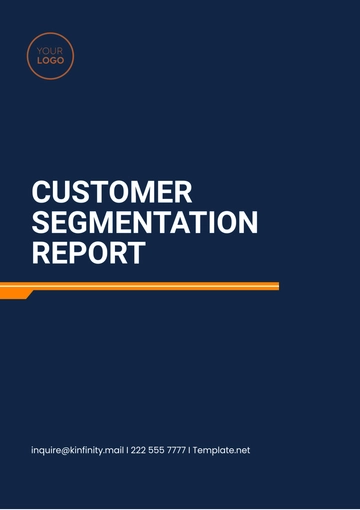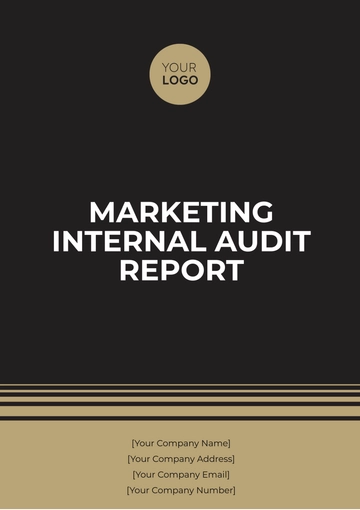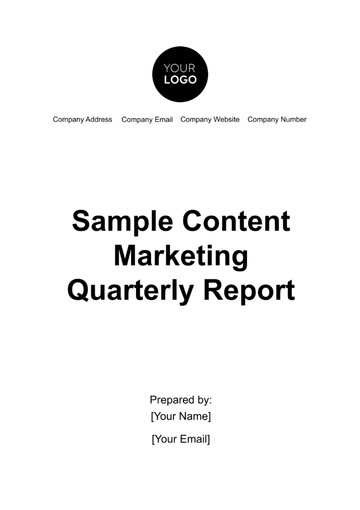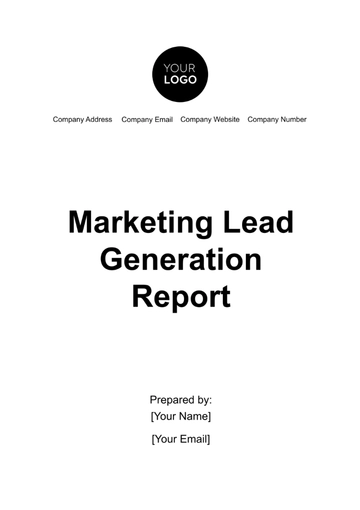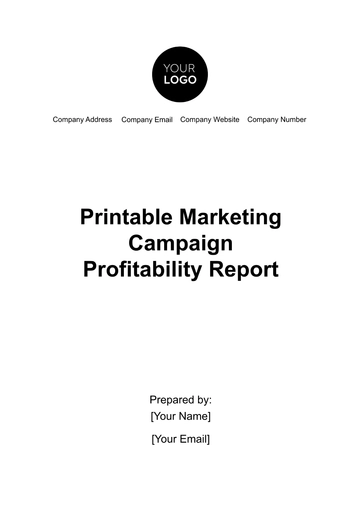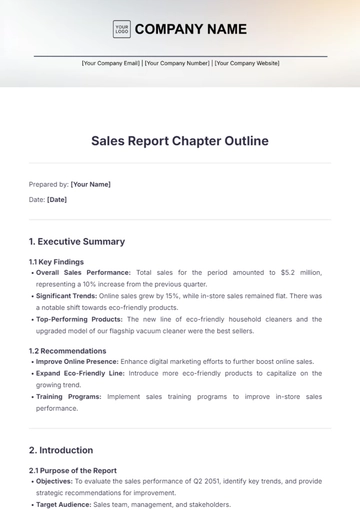Free Marketing Annual Performance Report
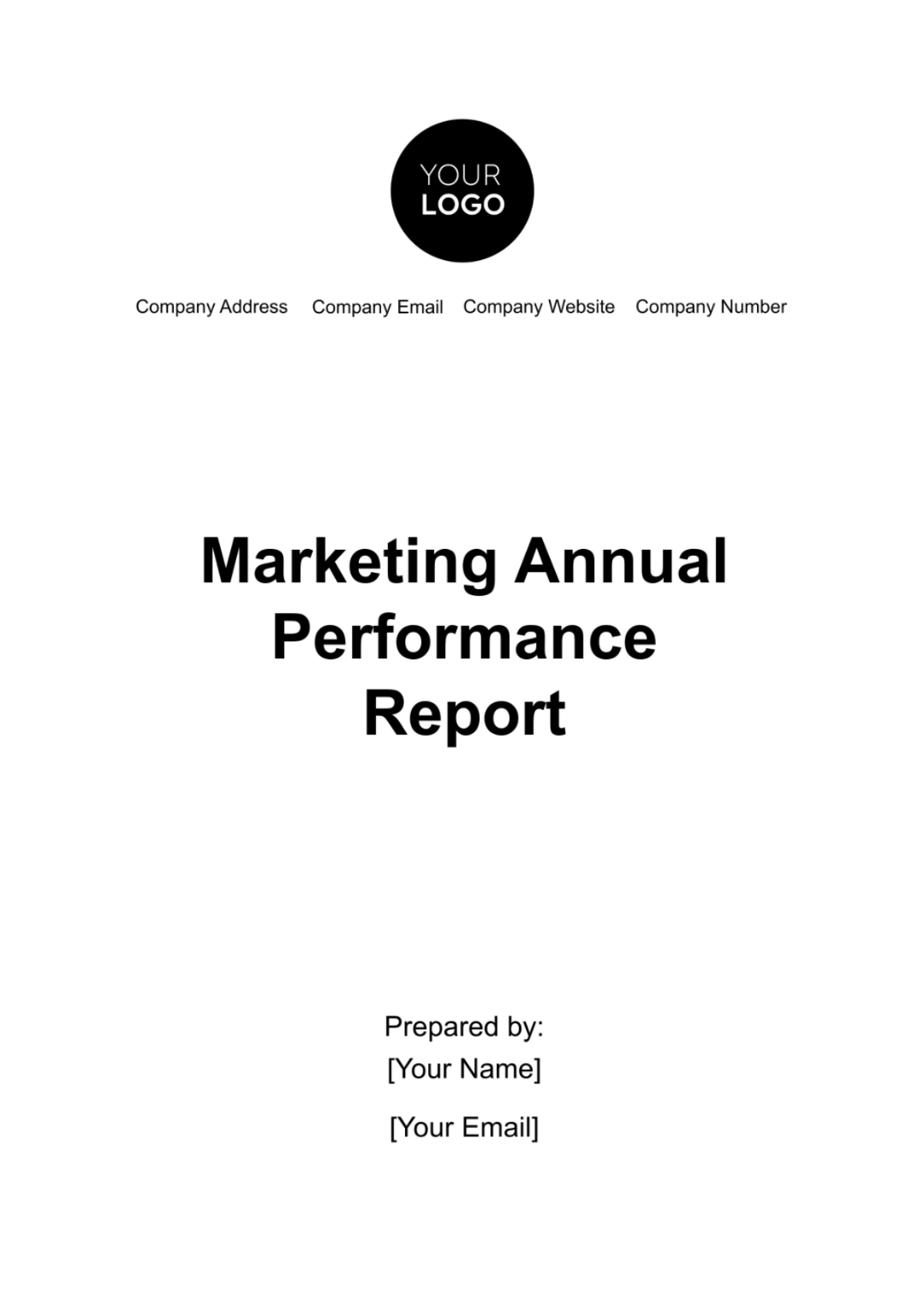
1. Executive Summary
This is a condensed but thorough overview of [Your Company Name]'s Marketing Annual Performance Report for the fiscal year [Year]. Designed to inform and guide decision-makers, this report offers in-depth evaluations of essential elements including objectives, target market metrics, competitive positioning, and financial outcomes. The data presented herein sheds light on the successes and shortcomings of [Your Company Name]'s current marketing strategy, giving stakeholders a clearer understanding of where the company stands in its journey towards achieving its business goals. By isolating key performance indicators and analyzing market dynamics, the report not only gauges the effectiveness of the past year's marketing activities but also provides strategic insights. This invaluable information sets the stage for actionable recommendations that aim to optimize marketing performance, customer engagement, and ROI for the upcoming fiscal year. The ultimate objective is to refine our marketing approach to better align with corporate objectives and adapt to evolving market conditions.
2. Objectives and Goals Overview
This section serves as a critical anchor point for evaluating [Your Company Name]'s marketing performance for the fiscal year [Year]. In any business operation, clearly defined objectives are the foundation upon which strategies are built and outcomes are measured. For this report, we highlight three primary objectives that were set at the beginning of the fiscal year: increasing market share, boosting online sales, and enhancing customer engagement. These objectives were chosen based on their direct alignment with the company’s broader mission and their pivotal role in driving business success.
In this section, you will find a tabulated representation of these objectives alongside the targeted goals, actual achievements, and variances. This straightforward layout facilitates an easy comparison and aids in identifying areas where the company either fell short or exceeded expectations. The variance figures, in particular, offer a quantifiable measure of our successes and challenges. Positive variances indicate where we have exceeded targets, providing valuable insights into strategies that could be replicated or expanded. Negative variances, on the other hand, serve as crucial indicators of areas that require focused attention and recalibration of strategies.
By examining this section, stakeholders can gain a holistic understanding of how the marketing strategies have fared in achieving the company's key objectives.
Objectives & Goals | Target | Achieved | Variance |
|---|---|---|---|
Increase Market Share | 10% | 9% | -1% |
Boost Online Sales | 25% | 20% | -5% |
Improve Customer Engagement | 15% | 18% | +3% |
3. Target Market Performance
The chapter is designed to provide a focused evaluation of [Your Company Name]'s engagement with its primary and secondary target audiences over the course of the fiscal year [Year]. Recognizing the specific demographics that resonate with our products or services is crucial for crafting tailored marketing strategies. For [Your Company Name], the primary market has been identified as Millennials aged between 24 and 35, while the secondary market comprises professionals aged between 36 and 50. This chapter delves into key performance indicators such as market share and customer retention rates for both these target markets. Understanding these metrics not only offers insights into the effectiveness of our current marketing strategies but also guides future campaign planning and resource allocation. The subsequent table presents a clear snapshot of how well we have performed in these chosen market segments.
4. Competitive Analysis
This section serves as a cornerstone in this comprehensive report, presenting a nuanced view of where [Your Company Name] stands vis-à-vis its principal competitors. But this goes beyond mere identification; it delves into a thorough understanding of each competitor's specific strengths, weaknesses, and market shares. This enables us to develop nuanced strategies that not only counteract competitors' advantages but also capitalize on their shortcomings. This level of insight is critical for planning marketing campaigns, refining our product assortment, and finetuning our pricing strategies. The goal is to inform smarter, more strategic decision-making that positions [Your Company Name] favorably in a competitive marketplace.
The table that follows this introduction outlines these attributes in detail, offering a side-by-side comparison of [Competitor A] and [Competitor B]. This comparative analysis serves as a foundational resource for strategy formulation and planning sessions. For instance, [Competitor A] has a strong online presence but lacks physical stores, suggesting potential avenues for our own expansion or marketing focus. Conversely, [Competitor B]'s expansive product range contrasts with their poor customer service, shedding light on areas where we can differentiate ourselves to capture more market share. By interpreting this data through a strategic lens, we can create targeted interventions that contribute to [Your Company Name]'s overall growth and industry leadership aspirations.
Competitor | Strengths | Weaknesses | Market Share |
|---|---|---|---|
[Competitor A] | Strong online presence | Limited physical stores | 20% |
[Competitor B] | Extensive product range | Poor customer service | 15% |
5. Marketing Mix Evaluation
The chapter delves into a detailed assessment of the four pillars of [Company Name]'s marketing approach, collectively known as the 4 Ps—Product, Price, Place, and Promotion. Each of these pillars serves a specific role in shaping the customer's perception and experience of the brand, thereby influencing sales, profitability, and overall market positioning. The table presented showcases the specific strategies that have been applied under each category and their corresponding effectiveness levels, quantified in percentages.
This comprehensive analysis offers an invaluable perspective on the areas where our marketing strategies have been most impactful, as well as those that may require further fine-tuning. For instance, the implementation of new product lines shows an 80% effectiveness rate, indicating a generally successful venture that resonated well with our target audience. On the other hand, dynamic pricing, with a 70% effectiveness, may necessitate revisits to pricing strategies or market segmentation to push that figure higher.
The highest effectiveness scores were seen in our promotional efforts—specifically social media and PPC campaigns—which stand at an impressive 90%. This suggests that our brand messaging and targeting strategies are highly resonant with our audience. Similarly, our move to enhance our online marketplace has seen an 85% effectiveness rate, affirming the consumer shift towards online shopping and indicating a successful adaptation on our part.
By dissecting each component's performance, we can make well-informed, data-driven decisions. This will allow us to optimize our marketing mix further, ensuring that each element is fine-tuned for maximum impact. With this evaluative framework, [Your Company Name] is better positioned to allocate resources effectively, capitalize on strengths, and address areas of improvement as we move into the next fiscal year.
Component | Strategy | Effectiveness (%) |
|---|---|---|
Product | New product lines | 80% |
Price | Dynamic pricing | 70% |
Place | Enhanced online marketplace | 85% |
Promotion | Social media and PPC campaigns | 90% |
6. Financial Performance
The chapter serves as a vital gauge of the ROI (Return on Investment) for [Your Company Name]'s marketing initiatives over the fiscal year [Year]. In any business environment, comprehending the financial outcomes of marketing activities is essential for long-term sustainability and growth. By systematically analyzing the cost and ROI of our key marketing endeavors, this chapter aims to provide stakeholders with a clear understanding of how investments in marketing are translating into business returns.
Table: Financial Overview of Marketing Campaigns
Item | Cost (USD) | ROI (%) |
|---|---|---|
PPC Campaigns | 10,000 | 15 |
SEO | 8,000 | 10 |
A. Discussion
PPC Campaigns:
Cost: $10,000
ROI: 15%
Analysis: The Pay-Per-Click campaigns proved moderately successful, delivering a 15% return on investment. Although the ROI is positive, the results indicate room for optimization. A further breakdown of the PPC metrics could reveal opportunities for better keyword targeting and ad placements.
SEO:
Cost: $8,000
ROI: 10%
Analysis: Search Engine Optimization efforts have produced a 10% ROI, which, while beneficial, suggests there might be potential for further gains. The focus should be on refining keyword strategies, improving site architecture, and enhancing content quality for better organic reach.
B. Recommendations
PPC Campaigns: Given the ROI of 15%, consider allocating additional resources to PPC campaigns after revisiting keyword strategies and optimizing ad placements.
SEO: Despite a 10% ROI, there’s scope for improvement. It is recommended to audit the SEO performance quarterly to adapt to search engine algorithm changes and competitor strategies effectively.
The Financial Performance chapter provides crucial insights into the monetary efficacy of [Your Company Name]'s marketing efforts. While both PPC and SEO have yielded positive ROIs, the numbers also indicate opportunities for strategic refinement. By acting upon these insights, we aim to optimize future marketing investments, making them more targeted, effective, and ultimately, profitable.
7. Key Insights and Recommendations
A. Key Insights
Market Share: The company was close to meeting its objective for market share growth, a promising sign that our positioning and outreach are generally effective. However, there's a marginal gap that needs to be closed.
Online Sales: Despite concerted efforts, the company fell short of its goals for boosting online sales. This suggests a need for revisiting and possibly revamping our online sales strategies.
Customer Engagement: On a positive note, customer engagement metrics exceeded expectations, which is indicative of strong customer relationships and effective community-building activities.
SEO vs PPC ROI: When looking at the return on investment, PPC campaigns outperformed SEO strategies. This data point suggests that PPC is currently a more effective channel for [Your Company Name] and may deserve more substantial resource allocation.
B. Recommendations
Optimize Online Sales Channels for Better Performance: The shortfall in online sales suggests that our current strategies might be lacking in some aspects. It's essential to review consumer behavior data, user experience (UX) designs, and funnel analytics to identify bottlenecks or points of friction that might be hindering sales conversions. Once these are pinpointed, strategic changes can be implemented to optimize the consumer's journey from discovery to purchase, thereby improving online sales performance.
Shift Some Resources from SEO to PPC for Better ROI: Given the higher ROI generated from PPC campaigns as compared to SEO, reallocating some resources might be advantageous. However, it's crucial not to abandon SEO entirely as it is a long-term strategy that builds organic credibility and authority. Consider running a more targeted PPC campaign, leveraging insights from existing data to optimize for clicks that are more likely to convert. At the same time, ongoing SEO efforts should be reviewed to ensure they are aligned with long-term brand objectives and industry best practices.
By considering these key insights and implementing the recommended actions, [Your Company Name] can aim to improve its overall marketing performance in the next fiscal year.
8. Conclusion
The fiscal year [Year] was a mixed bag of results for [Your Company Name], characterized by both hurdles and breakthroughs. While we fell short in certain objectives, such as boosting online sales and completely achieving our target market share, we witnessed remarkable success in vital areas, most notably customer engagement metrics. These outcomes serve as valuable learning experiences that will significantly inform and shape our strategic direction for the upcoming fiscal year. Utilizing the insights gleaned from this comprehensive review, we plan to refine our marketing strategies to ensure they are more aligned with our overarching corporate goals and adapt to evolving market demands. By taking these steps, we aim to not only meet but exceed our objectives in the next fiscal year, fostering sustainable growth and bolstering our market presence.
Prepared by:
[Person’s Name]
[Position]
[Contact Details]
[Date]
Approved by:
[Person’s Name]
[Position]
[Contact Details]
- 100% Customizable, free editor
- Access 1 Million+ Templates, photo’s & graphics
- Download or share as a template
- Click and replace photos, graphics, text, backgrounds
- Resize, crop, AI write & more
- Access advanced editor
This professional Marketing Annual Performance Report Template is a comprehensive tool designed to streamline the analysis of your marketing activities over the past fiscal year. It covers essential areas such as objectives, target market performance, competitive landscape, and financial metrics. This template allows businesses to efficiently evaluate strategies, identify areas for improvement, and make data-driven decisions for future marketing initiatives.
You may also like
- Sales Report
- Daily Report
- Project Report
- Business Report
- Weekly Report
- Incident Report
- Annual Report
- Report Layout
- Report Design
- Progress Report
- Marketing Report
- Company Report
- Monthly Report
- Audit Report
- Status Report
- School Report
- Reports Hr
- Management Report
- Project Status Report
- Handover Report
- Health And Safety Report
- Restaurant Report
- Construction Report
- Research Report
- Evaluation Report
- Investigation Report
- Employee Report
- Advertising Report
- Weekly Status Report
- Project Management Report
- Finance Report
- Service Report
- Technical Report
- Meeting Report
- Quarterly Report
- Inspection Report
- Medical Report
- Test Report
- Summary Report
- Inventory Report
- Valuation Report
- Operations Report
- Payroll Report
- Training Report
- Job Report
- Case Report
- Performance Report
- Board Report
- Internal Audit Report
- Student Report
- Monthly Management Report
- Small Business Report
- Accident Report
- Call Center Report
- Activity Report
- IT and Software Report
- Internship Report
- Visit Report
- Product Report
- Book Report
- Property Report
- Recruitment Report
- University Report
- Event Report
- SEO Report
- Conference Report
- Narrative Report
- Nursing Home Report
- Preschool Report
- Call Report
- Customer Report
- Employee Incident Report
- Accomplishment Report
- Social Media Report
- Work From Home Report
- Security Report
- Damage Report
- Quality Report
- Internal Report
- Nurse Report
- Real Estate Report
- Hotel Report
- Equipment Report
- Credit Report
- Field Report
- Non Profit Report
- Maintenance Report
- News Report
- Survey Report
- Executive Report
- Law Firm Report
- Advertising Agency Report
- Interior Design Report
- Travel Agency Report
- Stock Report
- Salon Report
- Bug Report
- Workplace Report
- Action Report
- Investor Report
- Cleaning Services Report
- Consulting Report
- Freelancer Report
- Site Visit Report
- Trip Report
- Classroom Observation Report
- Vehicle Report
- Final Report
- Software Report
